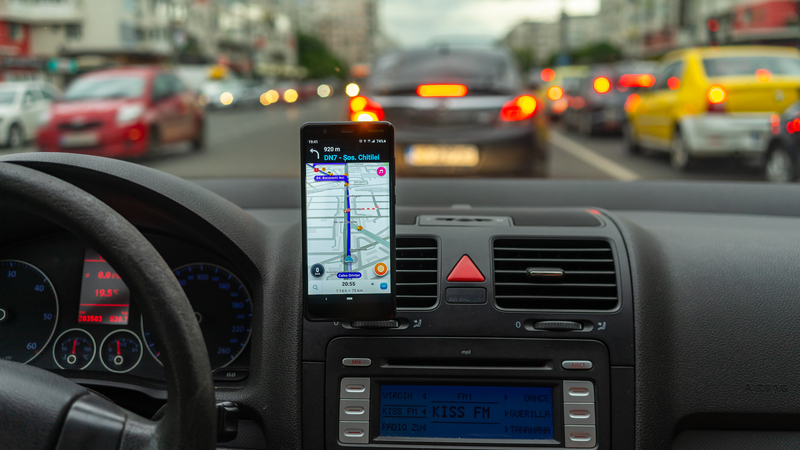
Between 2016 and 2019, 150 motorists died on the Orlando section of Florida’s I-4, earning it the grim title of one of the most dangerous highways in the US. Heavy congestion, complex interchanges, and distracted driving all contribute to high accident rates along the 347-mile span of highway and arterial roads.
It is an ideal location for the trial of a cutting-edge, Vehicle to Everything (V2X) traffic initiative being spearheaded by Dr. Rawa Adla, assistant professor of computer engineering at Florida Polytechnic University.
I-4’s position as a major artery connecting attractions including Walt Disney World, Universal Studios, and a host of sandy beaches creates a unique traffic dynamic. “Florida is a tourism state – everyone wants to travel to the Orlando amusement parks or to Clearwater and the beaches,” says Adla.
The mix of local commuters and out-of-state tourists unfamiliar with the roadway further contributes to its high accident rate. “That’s why it’s so important to improve safety in this critical area of I-4,” she adds.
The I-4 Frame (Florida Regional Advanced Mobility Elements) Project aims to tackle these challenges head-on. Supported by two grants totalling $252,000 from the Florida Department of Transportation (FDoT) as part of a broader USDoT initiative, Frame seeks to revolutionise traffic safety and mobility using V2X technology.
“The idea behind V2X is to enhance traffic mobility and safety by enabling cars to communicate with each other and with infrastructure,” says Adla.
With Florida Polytechnic University situated directly on I-4 between Tampa and Orlando, the project is ideally positioned to monitor and analyse the impact of these cutting-edge technologies. “We are at the heart of this work, located in a very critical location for the research,” says Adla.
A two-phase strategy
At its core, V2X technology facilitates real-time communication. Using this system, vehicles can receive critical updates about road conditions, upcoming lane closures or traffic light changes. For example, drivers can be warned about hazards such as sudden stops or red lights at intersections, preventing last-minute manoeuvres that often lead to accidents.
The real-world deployment of V2X technology focuses on providing drivers with timely, actionable information as well .
Launched in 2020, the I-4 Frame Project adopts a two-phase approach. Phase one, which concluded in March 2023, focused on evaluating the potential benefits of V2X technology using advanced traffic simulation models.
“I started by first creating multiple traffic transportation simulation models to replicate the actual scenarios on the I-4 on the road,” says Adla. “These models replicate the traffic on different days, different times of the day, different holidays, weekends. We created multiple models, and we compared the actual traffic using data we collected from [FDoT]. We then implemented V2X technologies into our simulation models and applied cutting-edge data analytics to quantify the benefits. We simulated the whole road and included cars with the same characteristics as those normally there, and then we evaluated the benefits. Our results showed that implementing this advanced technology will reduce the number of crashes and reduce travel time.”
“We can save human lives and reduce traffic times: we should be optimistic about the coming five years” Rawa Adler, Florida Polytechnic University
The simulation results suggest compelling results will arise from the physical implementation of a V2X system. The study compared the performance of physical on-board units (OBUs) with that of OBU emulators (OBUe), such as smartphones using data feeds from Florida’s FL511 Advanced Traveler Information System, offering live information on congestion events, crashes, construction and maintenance activities. It assessed the implementation of three main warning alerts:
Speed warning and enforcement results
According to the model, speed warning and enforcement alerts would cut crashes by 53% when all vehicles are equipped with OBUs, and see a 50% crash reduction when all vehicles are equipped with OBUe. The model also showed that with only a 20% market penetration, crashes could be cut by 16% and 17% (OBU and OBUe respectively).
Reduced speed zone warning and lane-closure alert results
Crashes could be cut by around 30% with both OBU and OBUe if all vehicles were equipped - and even with a 20% market penetration, crashes could be cut by 23% with OBU and by 19% with OBUe communications.
Emergency vehicle preemption results
Implementing emergency vehicle preemption (EVP) functionality into the system, giving priority at interchanges to emergency vehicles, could reduce collisions involving emergency vehicles by 70% and improve emergency response times between 14% and 50%, according to the model.
The potential safety improvements are clear even without the mass installation of on-board units, given the significant benefits that come with integrating such functionality into smartphones, says Adla.
“Drivers can download an app like FL511, which can act as a receiver using LTE communication. This ensures that even if only 20% of cars on the road are equipped with V2X, the system can still be effective. As soon as the implementation is done we're going to go over educating people how to use it and have it ready.”
From simulation to real-world impact
The real-world implementation of phase two is now underway. Beginning in mid-2024, more than 350 roadside units (RSUs) are in the process of being installed along the I-4 corridor to transmit information to V2X-equipped vehicles or smartphones with compatible apps.
The RSUs will transmit information to the vehicles advising what action to take - for example, warning of a lane closure ahead, enabling a vehicle to change lanes in good time. “It's not going to wait until the last minute, and this is going to enhance the traffic and we avoid the congestion,” says Adla.
Another implementation is RSUs at traffic lights giving vehicles warning that a light is about to change, enabling them to react more smoothly.
The roll-out of equipment is expected to be complete by May 2025 and while this happens, Adla is analysing the data collected from the ongoing physical implementation to identify any areas where there are failures or improvements in relation to what was expected in the models created in phase one.
“Phase two also involves collecting real-world data as the technology is implemented,” said Adla. “We aim to address any system malfunctions or limitations by continuously analysing the data.”

The era of autonomy
While the immediate focus is on improving safety and mobility, the I-4 Frame Project also sets the stage for the advent of autonomous vehicles. “Looking ahead, AVs represent the next frontier for this technology,” says Adla. “When vehicles are fully autonomous, they can seamlessly follow commands from the system, eliminating human error and variability in driver behaviour.”
By integrating V2X technology, self-driving cars could further smooth traffic flow, virtually eliminate accidents, and enhance mobility for individuals unable to drive.
Beyond safety, V2X technology offers significant environmental advantages. By optimising traffic flow and reducing idling, it lowers emissions and improves fuel efficiency. Smoother traffic conditions also translate to shorter journeys with their attendant human and economic benefits.
Frame’s success hinges on collaboration between multiple stakeholders, including technology providers, automotive manufacturers and local governments. FDoT has partnered with Florida Polytechnic University and other organisations to ensure the seamless integration of V2X technology into existing transportation systems.
Model for the future
The iniatiative is scheduled for completion by 2027, by which time Adla expects drivers along the I-4 to notice a much smoother commute.
The research will also help inform future transportation projects throughout the country.
Indeed, the I-4 Frame Project could serve as a blueprint for implementing V2X technology in other regions, says Adla.
“Our goal is to share lessons learned to encourage broader adoption of V2X technologies worldwide. Similar projects are underway in Texas and Michigan, and we’re learning from each other.”
The results of phase two will be shared in due course, she adds. “This project is going to be beneficial to everyone who is interested in implementing the V2X advanced technologies. We learn from each other. We will share our lessons learned with everyone from inside the US, outside the US, everywhere. I'm really happy and excited about these results. This study can be replicated in different areas in different countries. We have multiple lessons learned during the implementation. If we share these with different areas, we can save human lives and reduce traffic times. We should be optimistic about the coming five years. During that time, we will see great improvements on the road.”












